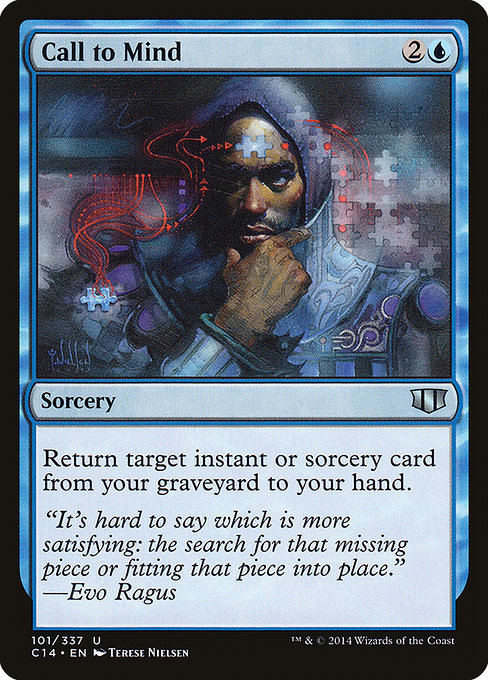
Image courtesy of Scryfall.com
Reading the delicate math of mana, effect, and tempo
Power and toughness are the classic way we measure a creature's raw punch, but in the modern game many of the most memorable moments come from calculating ratios in non-creature spells too. How much value do you squeeze out of a three-mana investment? Is a single card worth more when it comes from your graveyard back to your hand than when it simply sits in your library? These questions aren’t just theory; they guide deckbuilding, tempo, and late-game inevitability. 🧙♂️🔥💎
A case study in blue: Call to Mind
Call to Mind is a blue sorcery from Commander 2014 with a clean, elegant line of text: Return target instant or sorcery card from your graveyard to your hand. For {2}{U}, you’re paying three mana to retrieve a single spell from the grave, potentially reshaping the next few turns. That’s not a big creature-fight, but it is a careful arithmetic of resources: mana spent now for future options, turning the graveyard into a second hand that you can draw from again and again. In a world where blue often aims to out-tempo opponents, this is a textbook example of the value ratio blue thrives on: out-sourcing your next play while protecting your own skies from disruption. 🧙♂️🎲
Call to Mind sits in the Commander 2014 set (C14) as an uncommon reprint, a reminder that good blue spells can remain accessible and relevant long after their first printing. The card’s colors are unmistakably blue, identity clear in its mana cost and effect. It’s part of a broader blue toolkit that prizes card advantage, graveyard leverage, and multi-turn planning rather than raw power on a single swing. This is the kind of card that feels small in a vacuum but shines when your deck is built around recursions, stalling, and layered orchestration. 🧪🔵
“It's hard to say which is more satisfying: the search for that missing piece or fitting that piece into place.” — Evo Ragus
Design notes: art, flavor, and the ritual of recitation
Terese Nielsen’s artwork for Call to Mind channels puzzle-box aesthetics—the idea of pieces clicking into place after a careful search. The flavor text reinforces the theme of assembly and intention, a perfect pairing for players who savor the moment when a long-term plan snaps into focus. From a design perspective, the card demonstrates how a compact spell can wield outsized strategic impact when placed within the right deck architecture: a modest mana cost, a precise effect, and a granularity that rewards thoughtful sequencing. The frame and art direction in Commander 2014 also hint at the era’s emphasis on flavorful, character-driven pieces that feel both iconic and functional on the battlefield. 🎨⚔️
For players chasing the thrill of long-game planning, Call to Mind offers a window into blue’s philosophy: value is often a ratio, not a single, loud effect. The card’s relatively modest price point in today’s market—roughly a few dimes in common examples—belies its potential for genuine strategy when placed in the right hands and the right commander. And yes, it’s a fun reminder that sometimes the best answers come not from brute force but from a cleverly recycled toolbox. 🧙♂️💎
Why the ratio matters in deckbuilding today
When you compare a spell like Call to Mind to a typical one-shot draw, the “ratio” shifts: you’re trading immediate card draw for the possibility of reusing a crucial spell later. In commander and modern formats where graveyard setups are common, this ratio can swing a game in your favor without firing a single additional spell—your future options have more fuel. It’s a philosophy you’ll see echoed across blue shells that lean into versatile answers, threat control, and recursive engines. And if you appreciate the layered design, you’ll spot echoes of this principle in contemporary card design, where every mana investment earns a long-tail payoff. 🧲🎲
For collectors, Call to Mind also highlights how a card’s footprint—uncommon rarity, reprint status, and recognized art—contributes to its enduring appeal. The piece sits comfortably in many vintage and modern blue decks, functioning as a reliable pick for those who value flexibility and resilience in the late-game grind. The balance of cost, effect, and reusability makes it a tasteful example of why players fall in love with the craft all over again. 🔵🧩
As you refine your own ratios, consider how a single spell can unlock multiple pathways—whether you’re racing toward a combo, protecting a fragile plan, or simply ensuring that your graveyard isn’t a one-way street. And if you’re drafting or playing casually, the elegant efficiency of Call to Mind is a friendly reminder that thoughtful play can be every bit as thrilling as a flashy topdeck. 🧙♂️🎨
Speaking of stylish setups, your desk deserves something that keeps pace with your MTG mood. While you map out your strategy, why not upgrade your workspace with gear that nods to the multiverse? Our featured mouse pad brings a touch of tactical flair to the table—precision, comfort, and a dash of fantasy artistry to keep you focused on the game. 🔥💎
Custom Gaming Mouse Pad 9x7in Neoprene Stitched EdgesMore from our network
- https://crypto-acolytes.xyz/blog/post/understanding-lp-nfts-and-their-secondary-markets/
- https://blog.digital-vault.xyz/blog/post/brine-shaman-how-set-themes-shape-its-mechanics/
- https://blog.digital-vault.xyz/blog/post/parody-and-puns-unhingeds-biosynthic-burst-spotlight/
- https://transparent-paper.shop/blog/post/how-generative-ai-redefines-product-design/
- https://blog.digital-vault.xyz/blog/post/words-of-wisdom-tracing-enchantment-design-through-time/